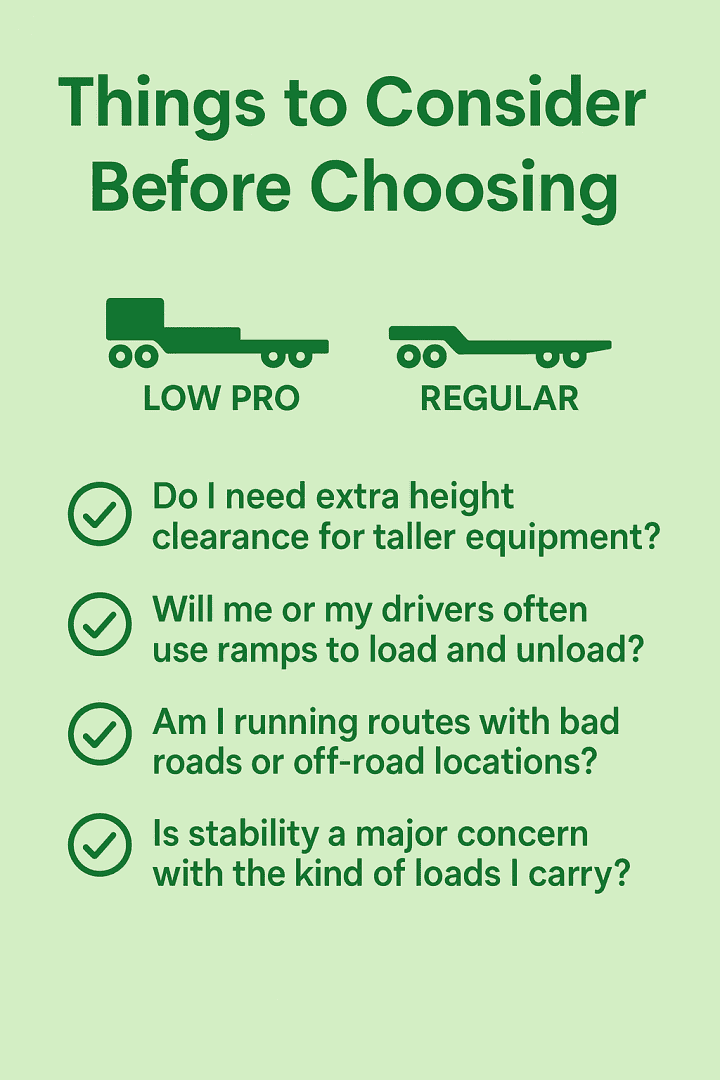When running a trailer fleet, choosing the right trailer makes a major difference. The type of deck trailer you use can affect what loads you can haul, how easy it is to load, and how much you can carry.
One common debate in the industry is whether to use a regular step deck trailer or a low profile step deck. While both options are useful, each one has its strengths. Let’s compare the low pro step deck and the regular step deck to help you decide which is best for your needs.
What Is a Step Deck Trailer?
Before diving into the differences, let’s quickly review what a step deck trailer is. A step deck trailer, also known as a drop deck trailer, has two deck levels: an upper deck and a lower deck. This design allows you to haul taller loads that wouldn’t fit on a flatbed because of height limits. Step decks are popular in construction, farming, and freight industries.
What Makes a Low Profile Step Deck Different?
The design of a low profile step deck trailer, also called a low pro step deck, is different. The biggest difference is the height of the lower deck. Regular step decks usually have a deck height from 36 to 42 inches, equipped with 22.5” tires. Low pro step decks are lower, normally equipped with 17.5” or 19.5” tires that bring their height to 35 inches or less.
Some manufacturers, like Reitnouer, add a leveling valve to their trailers. This lets drivers lower the trailer deck height to 33 inches.
The lower deck gives you some major advantages that a lot of fleet operators appreciate.
Benefits of a Low Profile Step Deck
1. Taller Load Clearance
The biggest advantage of a low profile step deck is the extra height it allows for loads. Because the deck is closer to the ground, you can carry taller equipment without going over legal height limits. This means fewer permits and less hassle on the road.
2. Easier Loading
When employing ramps, a lower deck also provides an easier angle. A low pro stepdeck makes loading and unloading safer and more efficient if you transport light machinery or forklifts.
3. Better Stability
A lower center of gravity gives the trailer better stability, especially when turning or driving in windy areas. If you’re hauling something tall or heavy, a low profile step deck trailer can reduce the risk of tipping.
4. More Profit
Low profile drop deck trailers let drivers book loads meant for lowboy or RGN (Removable Goose Neck) trailers. Customers pay better for such loads than regular step deck loads. Rates can be as high as $4-$10 per mile depending on season and area of transportation.

When a Regular Step Deck Is the Better Choice
One of the main drawbacks of low profile step deck trailers relates to their tires and overall ground clearance. We have discussed the clearance and the need for more experienced drivers. Also important to know the tire-related challenges that come with this type of trailer.
Low profile step decks typically run on 17.5″ or 19.5″ tires, which are smaller than the standard 22.5″ tires found on regular step decks. This difference can lead to several issues:
- Increased Wear and Overheating: Smaller tires rotate more frequently, leading to faster wear and greater heat buildup. This increases the risk of tire blowouts, especially at higher speeds. For this reason, drivers should consider maintaining speeds between 60–65 mph to reduce the risk of overheating.
- Higher Cost of Premium Tires: Because of the higher wear rate and overheating risk, it’s strongly recommended to use premium tire brands such as Michelin, Bridgestone, or Continental. While these tires perform better under pressure, they also come at a higher cost.
- Limited Availability on the Road: Tire sizes like 17.5″ and 19.5″ are not stocked as much as 22.5″. This makes finding replacements during a breakdown hard, especially in remote areas.
Even with all the benefits of a low profile step deck, regular step decks still have their place. They offer more ground clearance, which is helpful when traveling on rough or uneven roads. If you haul loads to remote locations or construction sites with poor road conditions, a regular step deck may be the safer choice.
Worth mentioning that, driving a low profile step deck trailer, often requires more skilled and experienced drivers.
Additionally, the extra frame height allows normal step decks to support somewhat heavier loads. A standard deck trailer may be better for you if you often transport large, heavy items like steel or concrete.
Things to Consider Before Choosing
When picking between a low pro step deck and a regular step deck, think about the types of loads you haul most often. Ask yourself:
- Do I need extra height clearance for taller equipment?
- Is ramp access a regular part of our operations?
- Do our regular routes include rough roads or off-road areas?
- Is stability a major concern with the kind of loads I carry?
Answering these questions will help guide your choice. Sometimes, fleets choose to run both types of trailers to cover all their bases.

Making the Best Decision
Both regular step decks and low profile step deck trailers are solid choices for any fleet. The right pick depends on what you haul and where you go. If you need more height, better loading angles, and a lower center of gravity, choose a low pro step deck. If your loads are heavy and your routes are rough, a regular step deck might serve you better.
A smart investment now can lead to fewer problems and more profit in the future.
Whether you’re expanding your fleet or swapping out older units, make your choice based on needs—not trends. Take a close look at what a low profile step deck can do—and decide if it’s the right move for your operation.





